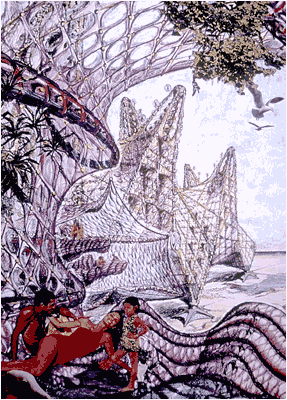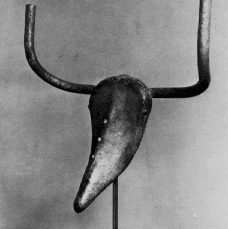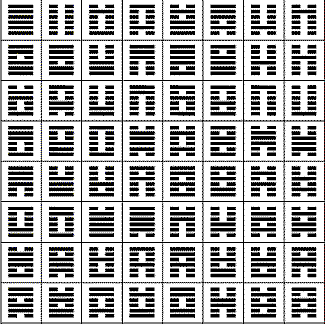2007.10.03 09:09
thesis
Perhaps you should design some kind of institution where architects can go to become less bitchy about petty things and in turn more ideas oriented. I see franchise opportunities--a Pride-Aid on corners everywhere.
2007.10.03 15:43
Apocalyptic Urbanism
Just wait:
Due to global warming Greenland becomes prime real estate. As a result Denmark becomes one of the northern hemisphere's big oil-rich nations. Jet-setters winter in Dubai and summer in Greenland.

I've never set foot on Greenland, but I have been there (back in 1963). Our plane needed fuel, so we landed somewhere in Greenland. It was night, so you couldn't see much, but I distinctly remember a single light burning over the door of a small building next to the runway. I remained enchanted.
2007.10.04 13:13
Apocalyptic Urbanism
How much of New York City 1807 still exists today? How much of New York City 2007 will still exist in 2207?
2007.10.04 16:18
Apocalyptic Urbanism
Catastrophic urbanism might be a better term, and indeed New Orleans during and post hurricane Katrina provides an ample textbook on the subject. Pockets of civilization may well succumb to catatrophes, but the rest of civilization does just go on. At least that's the situation now, and probably for some time to come. Even the Great Tsunami 2004 had widespread effect, but still on only a small portion of civilization at large.
It's probably more worthwhile to contemplate catastrophic urbanism than to conjecture apocalyptic urbanism.
2007.12.03 09:19
Guess Who
Both the profane and the sacred are human "being". Take away the qualifying hierarchy and you'll see the whole picture, which is much more.
After reading The Sacred and the Profane perhaps pick up Slovoj Zizek, The Puppet and the Dwarf: The Perverse Core of Christianity. It might help fill out the "whole picture."
...the subcategories of profane and sacred space:
fertile space
conceptual space
pregnant space
assimilating space
metabolic space
diaphragmic space
networked space
osmotic space
electromagnetic space
all-frequency space
for a school I'd go:
inside -- assimilating space and all-frquency space
outside -- metabolic space
2008.03.22 10:54
taking sexy back
multiple choice:
seminating imagination
ovulating imagination
fertilized imagination
conceptual imagination
pregnant imagination
pre-natal imagination
imagination of embryonic development
all of the above
| |
2008.03.22 14:53
Eisenman vs Zumthor theoretical approach
assimilation: absorption
extreme assimilation: purge
metabolic: creative/destructive duality
pre-natal: synaptical
all-frequency: synapses
still-born: delivery and that's it
pregnant: delivery forthcoming
2008.04.09 11:22
READING LIST
to clarify, when I wrote...
It may be well worth noting that the publication of S,M,L,XL closely coincides with the dawn of the easily-browsable/easily-publishable hypersized Internet. Ends and beginnings are both extreme situations
...it was in response to:
I don't think there's been a book [since S,M,L,XL] with such broad influence since. What do you think?
...meaning that, since S,M,L,XL, it's from the Internet that broad influence now emanates.
2008.04.09 14:23
READING LIST
You know, for me (like for most architects), architecture has always been a sort of tourist site.
2008.04.27 11:23
the state of drawing in education
I can still remember the first time I went "to do some CAD for fun in my spare time." It was Labor Day, 1983. By this time I had been employed as a CAD architect for just about four months. I mostly did contract documents, but I was also allowed to teach myself 3D modeling for like an hour a day. Outside of work, one of my interests then was the architecture of K.F. Schinkel. At the time it still wasn't clear to me how the staircase behind the columns of the Altes Museum worked, so I went to the office on Labor Day and started a model of the Altes Museum staircase.
Since June 1987 I've had my own CAD system at home, and in the last 21 years I have often done some CAD for fun in my spare time.
As far as the state of drawing in education, the main issue remains dexterity. Of course, if drawing by talking becomes a reality, then the main issue will be the gift of gab.

"Sorry, but I can't talk with you right now. I'm busy drawing the plans of my new house on the other line."
2008.04.27 12:00
the state of drawing in education
...there is abundant room for messiness and experimentation and discovery within CAD.
| |
2008.05.15 07:49
Eisenman's six point plan
Eisenman's points/arguments here are either flawed in logic, sentimental, academic, or self-serving. For example, "students are passive," yet the students described here are actually protesting. In terms of practice, deconstruction is one of architecture's most obscure styles and 'post-modernism' is still what the vast majority of architects do. Part of what's historically playing out now is Le Corbusier's late style and Kahn's early 'planning' style.
Anyone else love watching Boston Legal. Now there's a style architecture would do well to emulate.
2008.05.15 08:17
Now try taking it to court.
For the record:
"The duck is the special building that is a symbol; the decorated shed is the conventional shelter that applies symbols. We maintain that both types of architecture are valid--Chartres is a duck (although it is a decorated shed as well), and the Palazzo Farnese is a decorated shed--but we think that the duck is seldom relevant today, although it pervades Modern architecture."
--Learning from Las Vegas, four years after 1968.
Perhaps the case today is that the duck has become (via media) more relevant (to society), and the decorated shed has become more (true to form) ephemeral. I maintain that both these types of architecture are valid.
2008.05.15 20:48
The Official Paradigm Shift thread
multiple choice (so far):
1. typical plan meets eclectic program
2. eclectic plan meets typical program
3. programmatic planning meets typical eclecticism
4. planned eclecticism meets programmatic type
I'd say 2 and 4 characterize a paradigm shift.
2008.05.16 10:29
Now try taking it to court.
"The late period of artists is often under-rated. Picasso's Late Period was mostly disliked while he was alive--seen as repetitious and unimportant. Yet with Picasso dead, the late works were not so unimportant anymore, in fact they manifest one of Picasso's most creative periods.
Frank Gehry may be in a wonderful position if he continues to do architecture for another decade or so, because, when he isn't around anymore, his late works might just manifest his most creative period.
I like to look at and study the late periods of artists because of all the facile-ness and confidence and even (if you're lucky) the "I don't give a fuck" found there.
Philip Johnson produced an interesting late period, and he did change 'styles' with every new project, yet his overall style has always been reenactionary architecturism."
Rita Novel, 2005.08.23
If lateness does contain the possibilities of a new future paradigm, then I certainly hope the new paradigm is facile, confident and without giving a fuck. [Personally, I'm already moving from my early don't-give-a-fuck style to my high don't-give-a-fuck style, and God only knows what my late don't-give-a-fuck style is going to be like.
"Frankly, Stella, I don't give a damn."
I see a lot of late Le Corbusier meets universal Mies van der Rohe meets early planning Louis I. Kahn in the work of OMA, etc. Just one recent example: look at Kahn's Midtown [Philadelphia] Development (1956-57) and OMA's Quartier des Halles Urban Development Study (2003-04). And every time I now see Kahn's AFL-CIO Medical Services Center, I immediately also think of Herzog & de Meuron. There's a lot of mostly untapped inspiration within the unbuilt and lesser known architectural designs of the 20th century.
Does the science of recombinant genetics and even cloning harbor a new paradigm for architecture? Like the science, I think it's already happening within architecture, but, also like the with the science, it's a paradigm that many would rather deny.
2008.05.16 16:06
The Official Paradigm Shift thread
In the future, everyone will be a starchitect for fifteen minutes. That should satisfy everyone.
2008.07.05 11:44
architecture, technology, magic & war
The point of the great pyramids today is exactly that they make no sense; we don't even know how they were built. And, unless you believe in magic, the pyramid builders used a 'technology' that is somehow beyond us right now.
Just kill the notion of "how things were always done" because that's the real myth of your argument. "How things are done" has always been a very non-homogeneous set of situations. If you look closely, computers have (already) greatly enabled an even more vast proliferation of non-homogeneous ways of doing things.
There is a detectable magic in true non-homogeneous visionariness.
Historiography is now paradoxically caught up with writing predictions of the future, and that's because a true (magical) historian actually can simultaneously write about past, present and future events.
| |
2008.07.05 12:46
architecture, technology, magic & war
Almost all built architecture today is manifest within a regulated industry. And the regulations deal mostly with issues of safety and with issues of money (not necessarily in that order).
Visionary architecture is first manifest virtually, and sometimes, rarely even, passes through the regulations into built form.
Design/build a robot that will manifest a paradigm shift?
2008.07.05 17:46
How "futuristic" really is SCI_arc?

There's nothing like the good old-fashioned future.
2008.07.06 11:15
How "futuristic" really is SCI_arc?
Is there a way to photoshop not by HAND?
Drawing and collaging by WORD OF MOUTH, now that's futuristic!
| |
2008.07.15 21:12
bored with modern & contemporary, yet?

Picasso wasn't necessarily breaking any rules here, but he was being somewhat improper. What this work tells me is that Picasso recognized a sculptural potential in a bicycle seat and handle that when combined (improperly, in a way not done before) generated a masterpiece. I get the same sense when I look at Michelangelo's architectural detailing. Rather than simply breaking the rules, he saw potential in architectural details that others before him hadn't seen before, and he produced many improper combinations and many unprecedented details.
e.g., Porta Pia
Perhaps Michelangelo didn't even see classical architecture as a set of rules, rather a set of potentials. (And perhaps language/grammer too might not be seen as a set of rules, but rather a set of potentials).
2008.07.31 15:29
eisenman
...if you do intern at Eisenman, bone up on the I Ching before you get there, and then let it be known that the I Ching is one of your avocations via demonstrations of your meaningful chancyness. You'll have a blast!

2008.08.07 08:44
I smell a Vorläufer
"The errors that Robert Adam detected in Palladio's drawings for the reconstruction of the 'Baths', published in 1730 as Fabbriche antiche disegate da Andrea Palladio, encouraged a dismissive attitude to Palladio and led him to question the accuracy of the renaissance as a reliable recorder of classical architecture. It became easy for the brothers to delude themselves into thinking that they alone possessed a deep insight into the antique and had the knowledge necessary to correct the errors of renaissance draughtsmen. But such an arrogant stance was more a public one, which did not stand in the way of their serious study of the renaissance or their need to borrow directly from it, from time to time. The enormous variety found there appealed to them as much as the inventive classicism of the antique."
--Tait
Just as an aside, Fabbriche antiche disegate da Andrea Palladio was used in the formation of Roma Interrotta Sector VI.
Authorship Architects: A Work in Progress
1. Piranesi
2. Piranesi
3. Piranesi
4. Adam & Adam
5. Durand
6. Durand
7. Seroux d'Agincourt
8. Schinkel
9. Schinkel
Coda: Hejduk
2008.08.24 08:43
peter's canon
I am quite surprised by the many who have not recognized Gehry's influence. If anything, he joined and most clearly built a unity of modernist architecture as self referential practice of structure and the same as a flexible practice of hyper-noumena; that is to say a compound of the mineral tectonics of here-and-now and the sating buffet of architectonic plasma.
Modern architecture is fully present and wide awake, and all the quondam dreams and nightmares now manifest reality itself. Is not then a prescriptive therapeutic and/or pharmaceutical architecture surely to be marketed as well?
2008.08.26 12:41
"wildly influential" or really only virtually influential?
...perhaps cities are just becoming more and more incoherent.
|